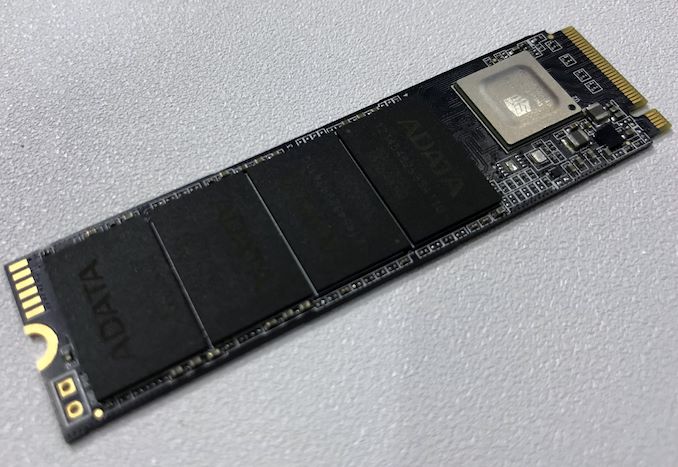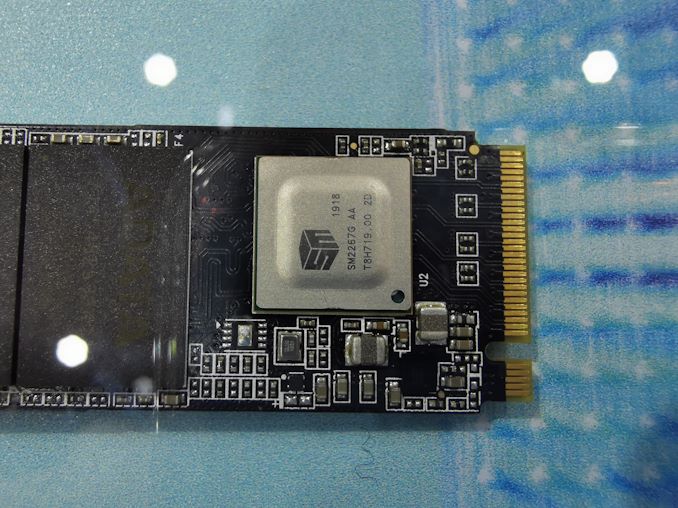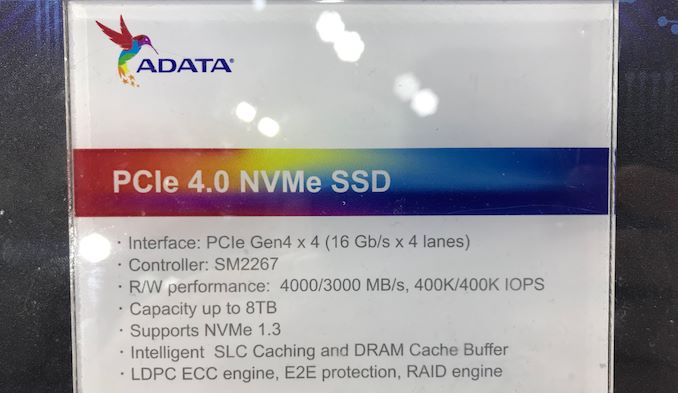ADATA Shows Off SMI’s Prototype PCIe 4.0 x4 512GB SSD: An SM2267 SSD
by Anton Shilov on May 30, 2019 3:00 PM EST- Posted in
- SSDs
- Storage
- ADATA
- Trade Shows
- Silicon Motion
- 3D NAND
- Computex 2019
- SM2267

One of the world’s largest suppliers of memory modules and SSDs, ADATA is a company to watch when it comes to the latest technologies. This is certainly the case with the ADATA’s next-generation SSDs featuring a PCIe 4.0 x4 interface featuring a Silicon Motion controller.
Right now, ADATA’s PCIe 4.0 x4 SSD based on Silicon Motion’s SM2267G controller only exists as a mockup, which is why the rear PB has a sticker that says 'SX6000' which is a low-end drive. The company sets a very conservative sequential read speed of up to 4 GB/s as well as a sequential write speed of up to 3 GB/s (this one will heavily depend on actual capacity) for the PCIe 4.0 drive, which is below what you typically expect from a next-generation SSDs, yet higher when compared to current-gen drives. Keep in mind though that firmware for the SM2267 is still in early stages of development and actual performance — when the drive is released sometime in early 2020 — will most definitely be higher.
On the functionality side of things, the ADATA PCIe 4.0 SSD as well as the SMI SM2267 controller we are talking about are actually next-gen products with a new engines inside and other improvements. Obviously, the controller supports the latest types of 3D NAND flash memory, so at present SMI is validating it with a variety of chips.
It is hard to say when exactly ADATA’s PCIe 4.0 x4 SSD based on the SM2267 controller will be available because the information we are told sometimes contradicts depending on the source. It is safe to say that the drive will be available in the first half of 2020 though.
| Want to keep up to date with all of our Computex 2019 Coverage? | ||||||
 Laptops |
 Hardware |
 Chips |
||||
| Follow AnandTech's breaking news here! | ||||||














6 Comments
View All Comments
Samus - Friday, May 31, 2019 - link
Where is the DRAM cache buffer? Are they talking about the 32MB built into the controller or host provided RAM?erinadreno - Friday, May 31, 2019 - link
If u read carefully enough ull find out that it's a mock-upSkeptical123 - Saturday, June 1, 2019 - link
The title also says prototype and the photo looks like it's a physical device with smd components meaning if there was going to be a DRAM cache buffer there's a good chance it would be on this board. Samus question is very valid if you "read carefully" the title or look at the photos.linuxgeex - Friday, May 31, 2019 - link
ROFL, 32MB is such a small amount that it would only matter if you were attaching the drive to a microcontroller. That can barely be enough to run the flash controller's firmware. There's no RAM on the board so this is a DRAM-less controller making use of host caching.leexgx - Saturday, June 1, 2019 - link
teh WD/sandisk controller has about 10mb of ram built into the controller so they don't suffer from the penalty of been full dramless (this is on the new WD Blue ssds)most SSDs don't use Host caching (HMB and i would not buy one if it did as your trusting that your ram will be 100% error free)
linuxgeex - Monday, June 3, 2019 - link
32MB of controller RAM is 256mb, so not sure why you are suggesting the WD/sandisk would somehow be superior. DRAM will always be on external chips. It makes no sense to fab DRAM at the node size of a controller's SOC, so they use SRAM instead. Using host caching is dangerous because of kernel lockups, hard resets, and power failures. It's nothing to do with memory being error free. If your host RAM is not error free then you will get corruption when the data is transferred from the unreliable DRAM, making the reliability of the storage is moot. If you care about that level of reliability then use ECC, dual power supplies, UPS, RAID 1/5 with battery-backed cache memory, use a journalling filesystem with write barriers enabled, lock your computer in a box so nobody can touch the reset button or insert a USB device.